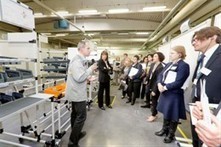Mar 30 2014
The Discovery of Lean | Narrated Prezi by Mark Warren
See on Scoop.it – lean manufacturing

This is a short version of a one-hour presentation I heard live a few months ago. Mark’s take is the result of more than 30 years of practical experience in all sorts of plants around the world and more than a decade of intensive research of original documents in numerous archives in several countries.
To understand where concepts and techniques are useful in manufacturing today, we need to know who invented them and for what purpose. The historical perspective is not a luxury, and the explanations of this history must be accurate if it is to enlighten us.
At historical research, Mark is a pro; I am an amateur. John Hunter thinks I have a “library full of dusty tomes.” In truth, I only have a few old books on manufacturing, half of them recommended by Mark.
See on prezi.com




Mar 31 2014
Working outside in rather than inside out | Bill Waddell
See on Scoop.it – lean manufacturing
“Perhaps one of the most inane – but very typical – aspects of the business process in manufacturers is the construction of the supply chain from the inside out. Three times in the last week – count ‘em – three for three – I visited a manufacturing company with (1) problems delivering in the time frame customers want; (2) lots of inventory but rarely the right inventory; and (3) a supply chain constructed by their supply chain people based on some idea of how to construct a supply chain but not one constructed based on a delivery objective.
In other words, some factory guys got together at some point – probably with an accountant or two breathing down their necks and decided this is how we purchase and this is how we schedule production and that is the resulting lead time, so sales …. Go out and try to shove those lead times down customers’ throats, regardless of what customers want or need….”
See on www.idatix.com
Share this:
Like this:
By Michel Baudin • Blog clippings 0 • Tags: batch, forecast, Inventory, Sales, supply chain. ERP